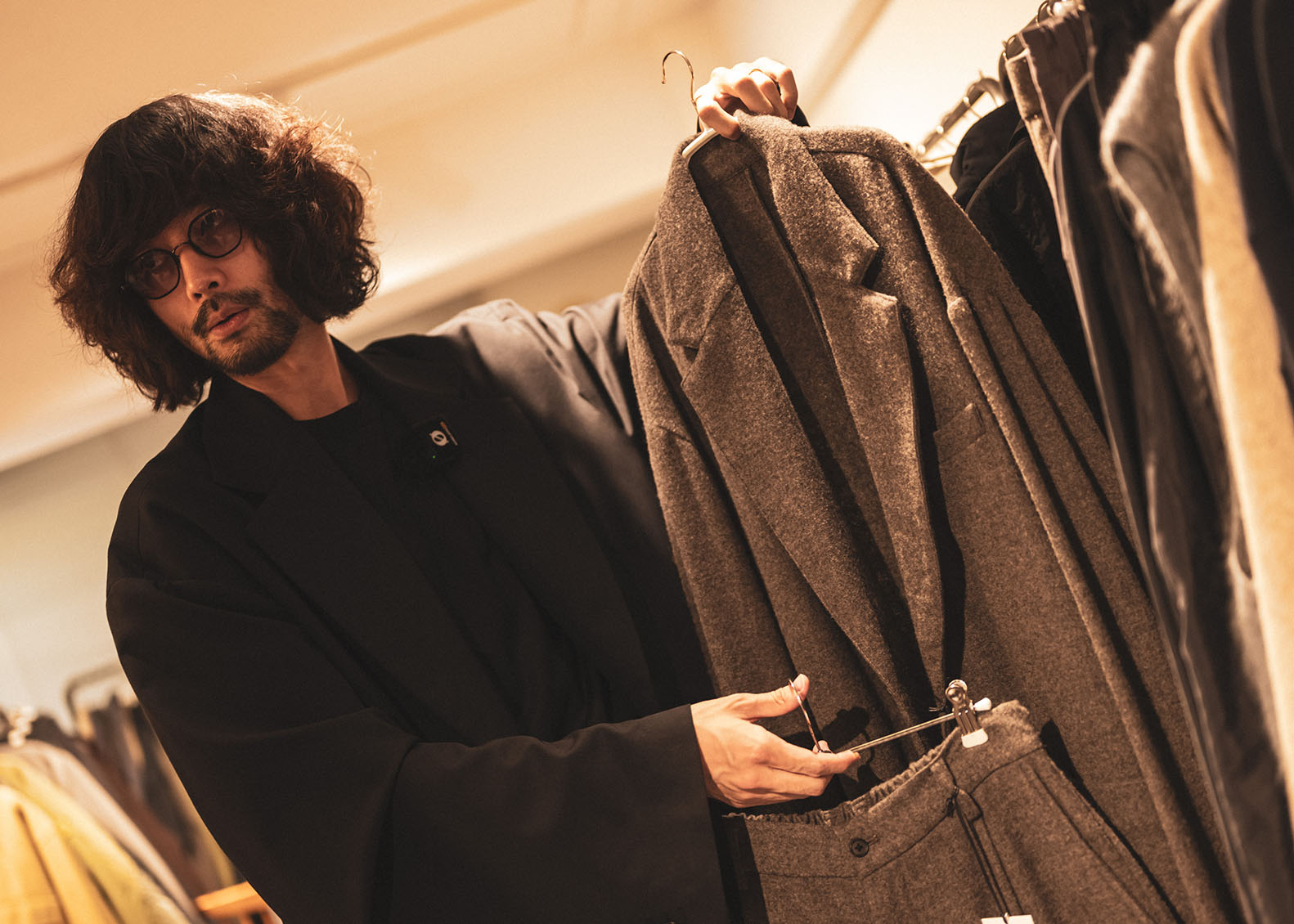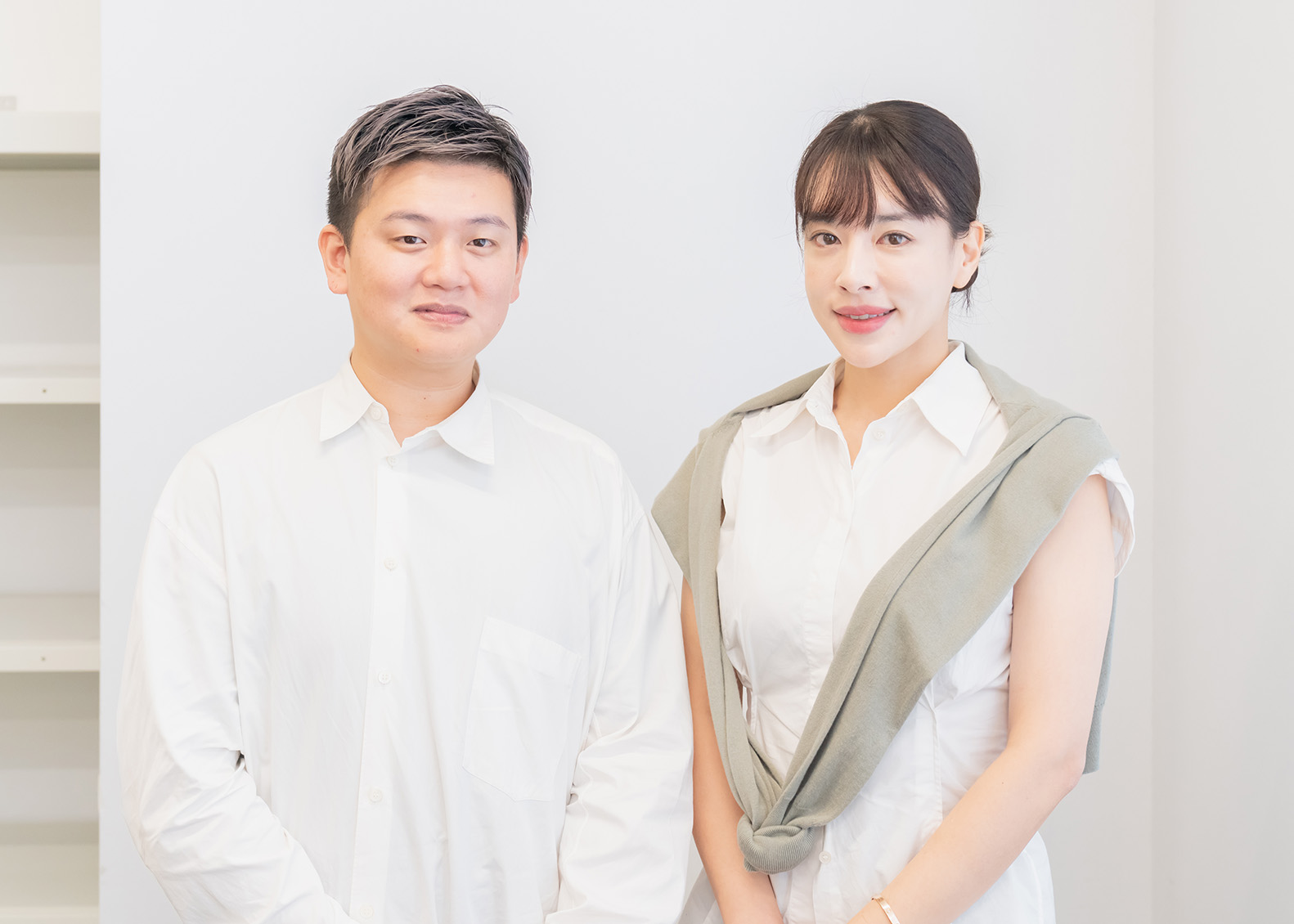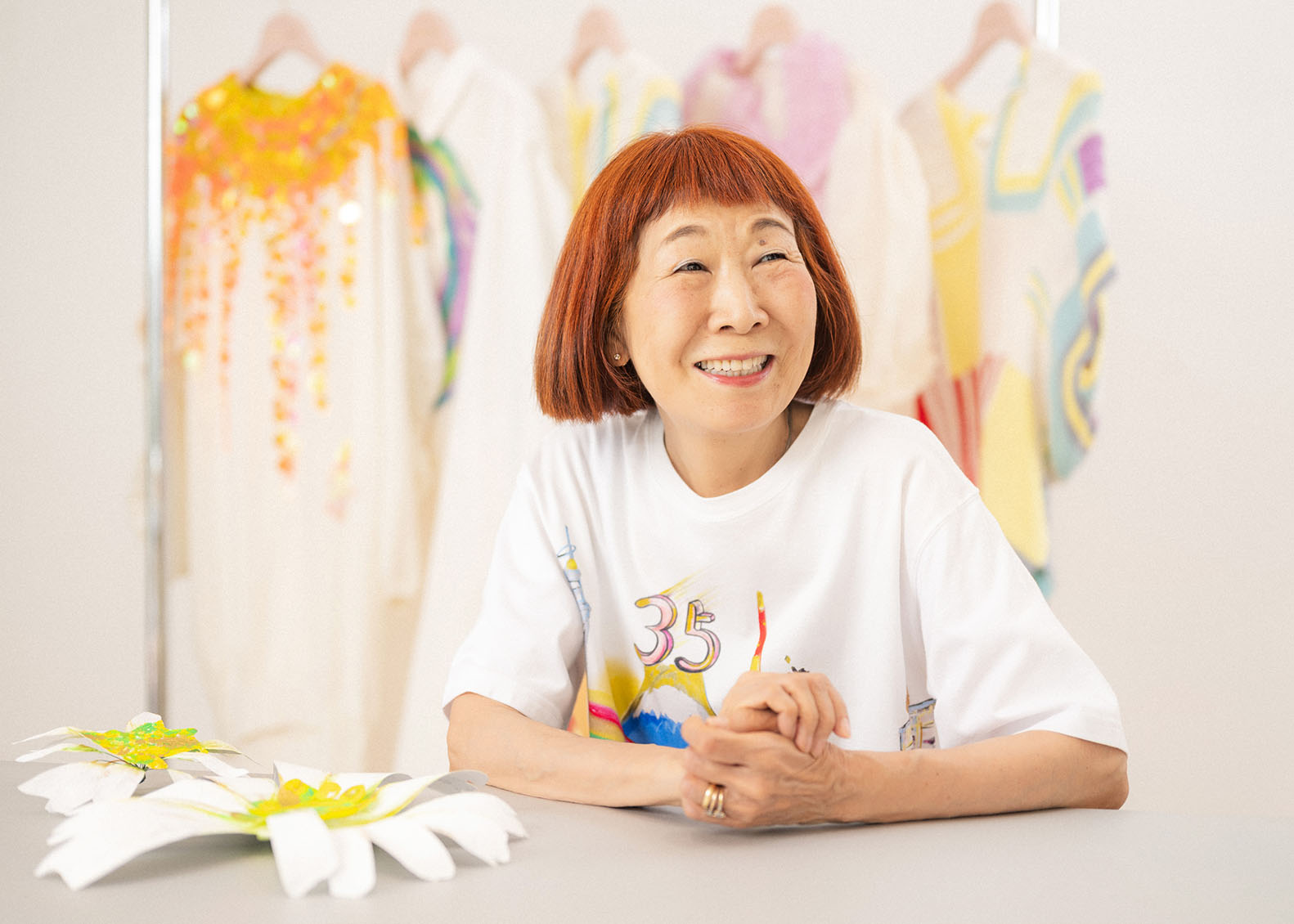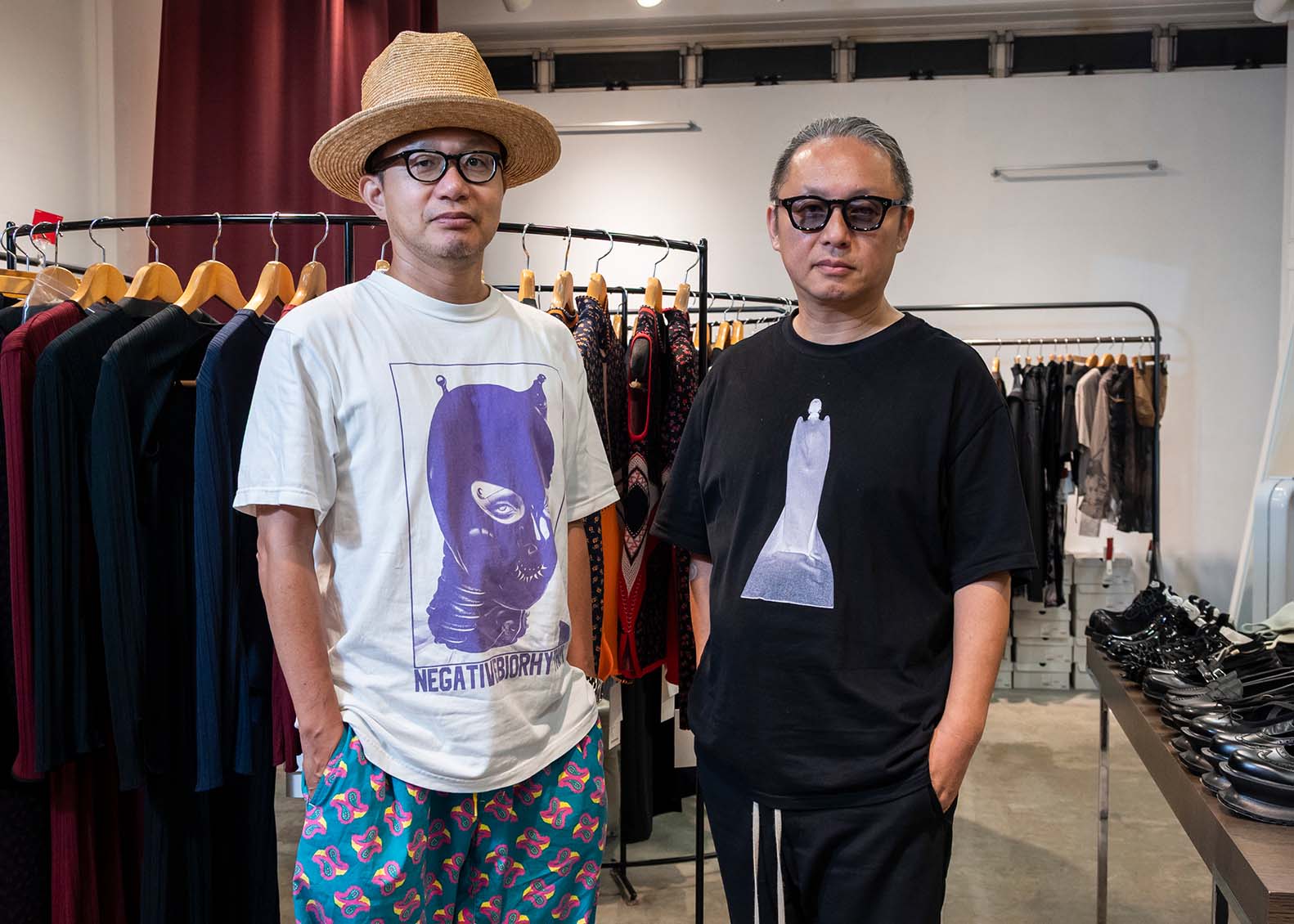MASAAKI HOMMA
Designer Masaaki Homma of mastermind JAPAN (“mastermind” hereafter), says “mastermind can mean “a person that is very talented in a certain area,” or a “key plotter,” and can be used to mean both good and bad things.”
Mastermind is now a brand that is so highly acclaimed internationally that it would not be an overstatement to say that it is the “high-end Tokyo-born brand with the highest number of fans in the world,” but things were not so smooth at the time of his debut. Reaching this point took a lot of suffering and hard work. The brand concept of “LOVE&PEACE” is the underlying concept that is applied to the manufacturing process of his designs, the people and fans involved in this process, and even Mr. Homma’s way of life.
We talked to Mr. Homma about “mastermind WORLD” that was held last year, the story of mastermind from its start to where it is now, and about Tokyo fashion and the market.
“mastermind WORLD” was held at the Hong Kong Convention and Exhibition Center in November 2010. It was an outstanding and gorgeous show, with the appearances of colorful collaborators and models typical of mastermind. What led to your decision to have a show in Hong Kong?
Homma:Asia is a crucial market. Mastermind has as many customers in other Asian countries as we do in Japan. We do not have a show every season, so I felt that having a show would be a sort of service to our customers. We mainly invited customers in Asian countries outside Japan, such as Hong Kong and Macau.
In “mastermind WORLD,” you announced your 2011 Spring-Summer collection and 2010-11 Fall-Winter collection jointly.
Homma:This show was kind of special, in that we wanted our customers to purely enjoy the show, and we wanted to show them mastermind’s world view. The show was held in mid-November, so timing-wise, it was the perfect time to show our new collection (2011 Spring-Summer), but by showing our 2010-11 Fall-Winter products, which are currently in stores, we can increase store sales. Our belief is to not only show customers our world view, but to do things in a way that benefit both the customers and the stores.
This show had a three-part configuration that started with Autumn-Winter, continued with collaborations, and then ended with our new collection. There are currently many political problems in Asia, so for the show music, we started off with John Lennon’s “Imagine,” followed by Bob Marley’s “One Love,” and ended with “We Are The World” by USA for Africa, with the hope that we could spread “LOVE&PEACE” in the world.




Although we cannot imagine it from the success of mastermind today, apparently you had quite a tough time in the first few years after launching your brand.
Homma:The first five years were tough. It was even hard work getting orders for 1 million yen. The real reason I went abroad was not to try my luck in the world, but because I thought of abandoning the brand. My clothes did not sell at all in the first three years after the launch, and I thought this meant that I had no talent. However, in order to quit, I needed a reason to say “I tried hard, but it didn’t work out” to the fabric stores and sewing plants which had helped me a lot over the years. It was really easy to say “I’m giving up since my clothes aren’t selling and I have no money,” but I felt that this might be rude to the people who had cheered me on. Therefore, I decided to try my luck abroad, and to quit if I still couldn’t sell my clothes. Although the reaction abroad was good at the start, I didn’t receive orders. A certain buyer that came to me in my first season told me in the second season that he liked my tastes and thought my products were good, but that it would be difficult to sell them in the U.S. I think he meant that the quality was not consistent with the costs, but at the time, I was selling T-shirts for about ¥4,000, and being told that this was still expensive got me thinking. Increasing the lot size would have helped reduce costs, but I could only think of how I would be in even more debt and be left with more stock if I increased production without having customers… That’s when I thought that I should make a product that couldn’t be compared with any other product—a product that would be expensive, but with a legitimate reason. I therefore did the total opposite of the buyer’s advice. As a result, I’m now selling products such as T-shirts for ¥50,000 and sweaters for ¥200,000. The quality is really good, so a buyer that took one look at our products at an exhibition said “get me an order form straight away,” but then he looked at the prices and said, “You’re crazy. Who’s going to buy these products at such prices?” (Laughs) That buyer who gave me the advice also looked at the order form with a grim expression and then left. But he then returned, and after a moment of tense silence, he said, “I’ll order,” and ordered millions of yen worth of clothes. I didn’t know this at the time, but he was a buyer for Maxfield, the famous Los Angeles specialty boutique.
Perhaps it was a turning point for your brand and was a big business opportunity?
Homma:At the beginning, I couldn’t believe that he would actually place an order, and was anxious that he’d call back later and cancel. However, I received the payment, and then I was anxious whether such expensive products would actually sell in stores, but they sold out in two weeks after being put on the shelves, and I got a call saying they wanted everything I had in stock. It was at this point that I realized that there was a market for our products and stores in which they would sell. I saw a glimmer of hope, although it was very distant. It made me rethink my purpose of making clothes as a designer, rather than thinking about making money or selling a lot. It also changed my attitude towards stores that ordered such expensive products and sold them, as well as towards the customers that bought them. I didn’t want them to think, “Oh, what happened to that brand?” I wanted them to say, “Wow, when did this brand become so amazing?” I think everyone has expectations for a brand. Even if the quality is good, if the customer has never seen or heard of the brand, its brand power is insufficient. I wanted my brand to become the sort of brand which customers can boast to others about, saying, “What! You haven’t heard of mastermind!?” I think that is the ideal fate of a brand as well as a way to show gratitude.
Going from a brand that sold ¥4,000 T-shirts to one that sold ¥50,000 T-shirts must also have been difficult in terms of production.
Homma:It became easier in terms of production. The Uniqlo boom was taking place around the year 2000, and mastermind was going against this trend, so when we told the fabric store that we were looking for “100% cashmere felt,” they asked, “Are you serious?” (Laughs) There were no other people that used such expensive fabrics in this age, so they sold us fabric in the amounts that we needed, such as 10m or 5m, and therefore it was really easy for us to procure our materials. The fabric stores treated us kindly, and the sewing factories know good fabric when they see it, so they were very cooperative. It felt like everything just fell into place.
I’ve been going to the Japan Creation (Japan’s largest general textiles trade show – abbreviated as JC) from the very beginning, but even if I went there for all three days, exchanged business cards, and requested swatches (fabric samples), only about five companies would actually send them to me. Among these, perhaps only one would lead to a sales negotiation. However, that one company became two, and then three… I still go to JC, but nowadays, if I leave my business card, they come running after me. (Laughs)
When sewing factories and fabric stores have good processes and fabrics sitting on the shelf without being used because they are too expensive for other brands, they bring them to me, thinking “mastermind might have a use for it!” We are not necessarily pursuing new made-in-Japan technologies. Advanced technologies existed from a long time ago, but no brands could take advantage of it due to price issues. Our prices are the result of using material that we believe is really high quality. People are impressed by things that they have never seen, and this is also true abroad. This is how we create clothes that are unique in the world. There are still many amazing technologies in Japan that have yet to be unearthed, and we enhance the uniqueness of our products by revealing them to the world. I believe that this is why people look at our brand and think, “Since the design is so elaborate, I guess the price makes sense.”
Mastermind sparked the “skull boom,” being a driving force that made skulls an indispensable motif in men’s fashion. What made you decide to make skulls the brand icon?
Homma:I always liked this motif. In the past, when I was thinking of why my clothes wouldn’t sell, I recalled my experiences working as a salesperson at Yohji Yamamoto. At the time, the best-selling items were a collection that used skulls as motifs, and I seem to recall that skulls were used in the collections that triggered the huge popularity of UNDERCOVER and NUMBER (N)INE. The skulls in each of these collections were really unique to the brand, which I thought was amazing. I wanted to create a skull motif that was better than any other brand, even if by my own criteria, and I believed that I should not use this motif unless I accomplished this.
How do you conduct your design work? What is the source of inspiration for your designs?
Homma:I don’t use computers at all, and do all my designs by hand. I can’t draw if people are nearby, even my wife (laughs). So when I draw my designs, I am completely alone.
My source of inspiration is everything that I see in my daily life. For instance, I look at a person walking on the street and think “the length of the top along with the volume of the pants is cute,” or I look at a truck on the road and think, “That’s a good color scheme.” I note the color contrast and balance in the volume of clothing, rather than the designs, and I note down things that strike me as interesting. So my mind is working 24 hours a day.
You mentioned that you check out the people walking in the streets; what do you think about the current fashion market and Tokyo fashion?
Homma:Tokyo fashion is very unique to Tokyo, and I think that it is a city that is passionate about fashion. The current market is said to be somewhat lackluster, but people really do like fashion. I think it may be a national trait, and I don’t think there is reason to be pessimistic. However, right now, the buyers are quite demanding, and are more knowledgeable that we people on the production side think. I think the current slump in sales is a result of the people on the production side lacking skills or being too lazy. Perhaps it isn’t that people both young and old have lost interest in fashion, but that they have become able to shop in a cool-headed manner.

2009 A/W “serenade” catalog cover
A limited number of 1,000 copies are distributed world wide to customers and clients at the end of each season as a way of summing up the entire season. Also includes information on collaborative items.
You mentioned that after the 15th anniversary of mastermind, you are going to take a break. I think many fans will be saddened by this news. Why did you decide to take a break? Also, what are your plans for the future?
Homma:We will have our final exhibition from 2010 Summer to Fall, and will stop after delivery of 2013 Spring-Summer. I’d told the relevant parties on the 10th anniversary of mastermind that I would stop at the 15th anniversary.
When we celebrated our 10th anniversary, I felt that the reason we’d gotten this far was due to everyone that supported us, and I decided to focus on spending the last five years repaying these people. Coincidentally, “mastermind JAPAN” has exactly 15 letters.
After deciding to halt the brand on its 15th anniversary, we’ve been creating catalogues. Ten seasons in five years—it’s the same as the number of letters in “mastermind,” so we’ve created catalogues that spell out the word “mastermind” when they are all assembled. The season themes have also been “M=majestic,” “A=ace-high,” “S=serenade,” “T=timeless,” “E=evermore,” “R=radiance,” “M=mindblow”… we will end with “D,” and taking the first letter of each word will spell “mastermind.” All the words have eight letters; a lucky number, in the hope that all of you will be blessed with good luck.
I really haven’t thought about what to do after our 15th anniversary…conversely, I will not be able to work up to the 15th anniversary if I think about that. I have decided that I will spend the last five years focusing on successfully making it to our 15th anniversary.

2009 A/W “serenade”

2009 A/W “serenade”

2010 A/W “evermore”
Finally, please give a message to all those people aiming to work in the fashion industry.
Homma:I believe that it is important not to become excessively self-conscious, although this may be somewhat of a tendency for designers. When doing shows, look at things from the perspective of your customers, and provide surprise and enjoyment. I believe that it is not possible to have a well-supported brand by providing surprise without enjoyment. There are many brands that create good quality items nowadays, but that alone won’t draw customers, so it is important to think about the total package—price, planning, timing of release, etc. In the past, the conventional route was to first become a hit in Japan and then do shows abroad, but we broke with this convention. There are many different ways to do things, so rather than being pessimistic due to poor sales in Japan, I encourage you to try your luck out in the world, if only for one season!





